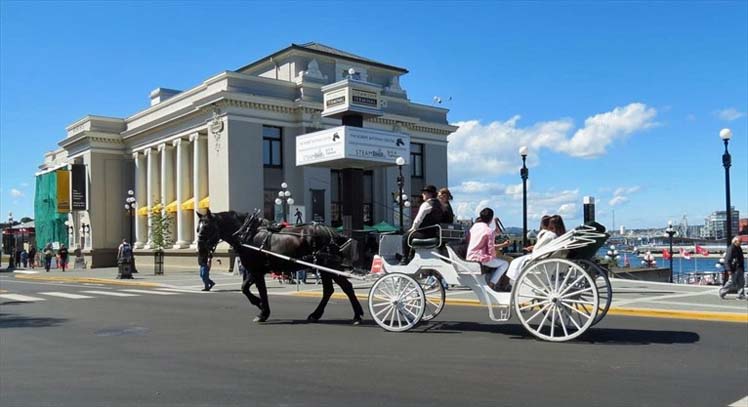
the Victoria waterfront - Date/Photographer unknown.
Was a Polarizing Figure
Victoria Vancouver Island British Columbia - Fear of an earthquake created one of Canada's finest art galleries.
For nearly 50 years the Royal London Wax Museum occupied the 94-year-old Canadian Pacific Railway (CP) Steamship Terminal on Victoria's Inner
Harbour.
The iconic building looks a like a Greek temple, but it was built on wooden pylons that are anchored in rubble at the bottom of the harbour.
The wax museum was one of Victoria's most popular tourist attractions, but the building's owner, the province of British Columbia, feared the building would
collapse if an earthquake hit the city.
The wax museum museum had to move out so more than $3 million in restoration work could reinforce the building.
The museum couldn't afford to move back in a year later.
But that opened up an opportunity for the Robert Bateman Centre to move into the waterfront building.
Many of Bateman's best known paintings, plus the story of his career, now occupy the second floor of what had been built as a steamship terminal for CP
passenger ships.
A high-end seafood restaurant occupies much of the main floor, along with a Robert Bateman gift shop.
A little-known feature of Bateman's art is revealed in his museum.
In his early career, and while head of the art department at Nelson High School in Burlington, Bateman was primarily an impressionist painter doing abstract
cubism, similar to Pablo Picasso.
A friend invited him to Buffalo's Albright-Knox Art Museum in 1962 to see the work of Andrew Wyeth.
Wyeth was a prominent realist painter.
His paintings look almost like photographs.
Bateman was blown away by Wyeth's work, and the rest is history.
Bateman became a world renown realist painter.
Many of his original freehand sketches from the field of birds, animals, and landscape are displayed in the museum, along with Bateman's written explanations
of his artwork.
The building itself is a piece of art.
It was designed by one of British Columbia's best known and most controversial architects.
Francis Rattenbury designed the steamship terminal, plus the spectacular B.C. Legislature across the street, and the renowned Empress Hotel sitting
kitty-corner from the legislature.
They're all very creative and magnificent designs, but Rattenbury was never a legitimate architect.
When he arrived in Vancouver from England in 1891 the new province decided it needed an impressive government headquarters and announced a design
competition.
Rattenbury entered a design that impressed the judges, but they wanted to see other buildings he had designed, of which there were none.
Rattenbury happened to have an uncle in England with the same name, and an accomplished architect.
Rattenbury had his uncle ship some of his architectural drawings to Vancouver and he presented these as his own.
He got the contract, and the B.C. Legislature is one of the most impressive government buildings in Canada.
With his reputation enhanced by the legislature project, CP hired Rattenbury in 1904 to design an impressive hotel on the Victoria waterfront.
Rattenbury had a swampy corner of the harbor filled in and that is where the Empress stands today.
CP was so impressed with its new hotel, they hired Rattenbury to design a new terminal for its busy passenger ship business that served the west coast of B.C.
and American states.
Rattenbury's bloated ego prompted him to leave his wife and four children and hook up with Alma Pakenham, a woman 40 years younger than him.
Victoria's upper crust society rejected Rattenbury and he eventually moved back to England with his young wife.
A couple years later Rattenbury was beaten to death in his home at age 68.
His young wife and her lover, the couple's 18-year-old chauffeur, were charged with his murder.
Alma Packenham was acquitted of the murder, but committed suicide three days later.
The chauffeur, George Percy Stoner, was convicted and sentenced to death, but a deluge of more than 300,000 protest letters to the Home Secretary by people who
believed Alma had pushed the chauffeur to kill her husband resulted in his sentence being commuted to life in prison.
However after five years in prison Stoner was released to join the British Army fighting Hitler and died in 2000 at age 84.
Pat Brennan.
provisions in Section 29 of the Canadian
Copyright Modernization Act.

